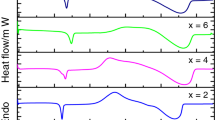Abstract
The glass formation and devitrification of intermediate alloys in the Sb–Ge–Se system were studied by differential scanning calorimetry. A comparison of various simple quantitative methods to assess the level of stability of the glassy materials in the bove mentioned system is presented. All of these methods are based on characteristic temperatures, such as the glass transition temperature, T g, the onset temperature of crystallization, T in , the temperature corresponding to the maximum crystallization rate, T p, or the melting temperature, T m . In this case, k gl may be more suitable for estimating the glass thermal stability in above composition range than ΩT. In this work the parameter K r (T) is added to the stability criteria. The thermal stability of some ternary compounds of the Sb–Ge–Se type has been evaluated experimentally and correlated with the activation energies of crystallization by this kinetic criterion and compared with those evaluated by other criteria. All the results of criteria and kinetic parameter K r (T) confirm that the thermal stability decrease with increasing Sb content in the glassy system. The crystallization results are analyzed and both the activation energy of crystallization process and the crystallization mechanism are characterized. Finally, identification of the crystalline phases was made by recording the X-ray diffraction pattern of the transformed material. This pattern shows the existence of microcrystallites of two phases, the first is germanium Selenide GeSe2 and the second is Sb2Se3 in amorphous matrix for annealed of Sb2.5Ge22.5Se75 and Sb10Ge15Se75 glass.












Similar content being viewed by others
References
Tanaka K, Osaka Y, Sugi M, Iizima S, Kikuchi M. Kinetics of growth of conductive filament in As-Te-Ge glasses. J Non-Cryst Solids. 1973;12:100–14.
Shaaban ER. Non-isothermal crystallization kinetic studies on a ternary, Sb0.14As0.38Se0.48 chalcogenide semi-conducting glass. Phys B. 2006;373:211–6.
Sugiyama Y, Chiba R, Fugimori S, Funakoski N. Crystallization process of In-Te alloy films for optical recording. J Non-Cryst Solids. 1990;122:83–9.
Bindra KS, Suri N, Kamboj MS, Thangaraj R. Structural and transport properties of amorphous Se-Sb-Ag chalcogenide alloys and thin films. Thin Solid Films. 2002;516:179–82.
Savage JA, Webber PJ, Pitt AM. An assessment of Ge-Sb-Se glasses as 8 to 12 μm infra-red optical materials. J Mater Sci. 1978;13:859–64.
Giridhar A, Narasimham PSL, Mahadevan S. Electrical properties of Ge-Sb-Se glasses. J Non-Cryst Solids. 1980;37:165–79.
Shaaban ER, Dessouky MT, Abousehly AM. The effect of Bi content on the thermal stability and crystallization of Se-Te chalcogenide glass. Philos.l Mag. 2008;88:1099–100.
Shaaban ER, Dessouky MT, Abousehly AM. Glass forming tendency in ternary GexAs20Te80−x glasses examined using differential scanning calorimetry. J Phys Condens Matter. 2007;19:096212.
Sakka S, Mackenzie JD. Relation between apparent glass transition temperature and liquids temperature for inorganic glasses. J Non-Cryst Solids. 1971;6:145–62.
Dietzel A. Glass structure and glass properties. Glasstech. 1968;22:41.
Hruby A. Evaluation of glass-forming tendency by means of DTA. Czech J Phys B. 1972;22(22):1187–93.
Saad M, Poulain M. Glass forming ability criterion. Mater Sci Forum. 1987;19:11.
Surinach S, Baro MD, Clavaguera-Mora MT, Clavaguera N. Glass formation and crystallization in the GeSe2-Sb2Te3 system. J Mater Sci. 1984;19:3005–12.
Hu L, Jiang Z, Chin J. A new criterion for crystallization of glass. Ceram Soc. 1990;18:315–21.
Vazquez J, Lopez-Alemany PL, Villares P, Jimenez-Garay R. Evaluation of the glass forming ability of some alloys in the Sb-As-Se system by differential scanning calorimetry, J. Alloys Compd. 2003;354:153–8.
Shaaban ER, Kansal I, Shapaan M, Ferreira JMF. Thermal stability and crystallization kinetics of ternary Se-Te-Sb semiconducting glassy alloys. J Therm Anal Calorim. 2009;98:347–54.
Shaaban ER, Shapaan M, Saddeek YB. Structural and thermal stability criteria of Bi2O3-B2O3 glasses. J Phys Condens Matter. 2008;20:155108.
Kissinger HE. Reaction kinetics in differential thermal analysis. Anal Chem. 1957;29(11):1702–6.
Shaaban ER, Kaid MF, Moustafa E, Adel A. Effect of composition variation on the optical properties of Sb-Ge-Se thin films. J Phys D. 2008;41:53125301.
Vazquez J, Lopez-Alemany PL, Villares P, Jimenez-Garay R. Generalization of the Avrami equation for the analysis of nonisothermal transformation kinetics. Application to the crystallization of the Cu0.20As0.30Se0.50 alloy. J Phys Chem Solids. 2000;61:493–500.
Johnson WA, Mehl RF. Reaction kinetics in processes of nucleation and growth. Trans Am Inst Min Met Eng. 1939;135:416–58.
Avrami M. Kinetics of phase change. J Chem Phys. 1940;8:212–24.
Avrami M. Granulation, phase change, and microstructure kinetics of phase change III. J Chem Phys. 1941;9:177–84.
Sanchez-Jimenez PE, Criado JM, Perez-Maqueda LA. Kissinger kinetic analysis of data obtained under different heating schedules. J Therm Anal Calorim. 2008;94:427–32.
Wagner C, Villanes P, Va′zquez J, Jirnenex-Caray R. Some methods for kinetic studies of non-isothermal crystallization in Sn0.08As0.26Se0.66 alloy. Mater Lett. 1993;19:370–5.
Gao YQ, Wang W, Zheng FQ, Liu X. On the crystallization kinetics of Pd80B4Si16 glass. J Non-Cryst Solids. 1986;81:135–9.
Matusita K, Saka S. Kinetic study of crystallization of glass by differential thermal analysis—criterion on application of Kissinger plot. J Non-Cryst Solids. 1980;38–39:741–6.
Mahadevan S, Giridhar A, Sing AK. Calorimetric measurements on As-Sb-Se glasses. J Non-Cryst Solids. 1986;88:11–34.
Acknowledgements
The authors are grateful to Al-Azhar university Faculty of Science Physics department Assuit branch for financial support.
Author information
Authors and Affiliations
Corresponding author
Rights and permissions
About this article
Cite this article
Shaaban, E.R., Tomsah, I.B.I. The effect of Sb content on glass-forming ability, the thermal stability, and crystallization of Ge–Se chalcogenide glass. J Therm Anal Calorim 105, 191–198 (2011). https://doi.org/10.1007/s10973-011-1317-z
Received:
Accepted:
Published:
Issue Date:
DOI: https://doi.org/10.1007/s10973-011-1317-z




